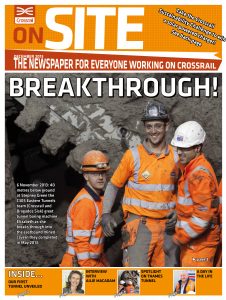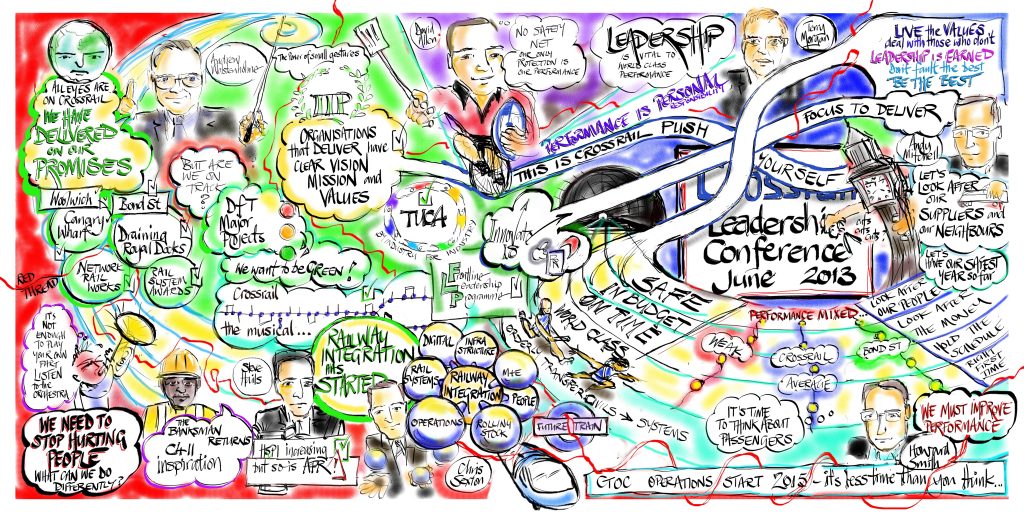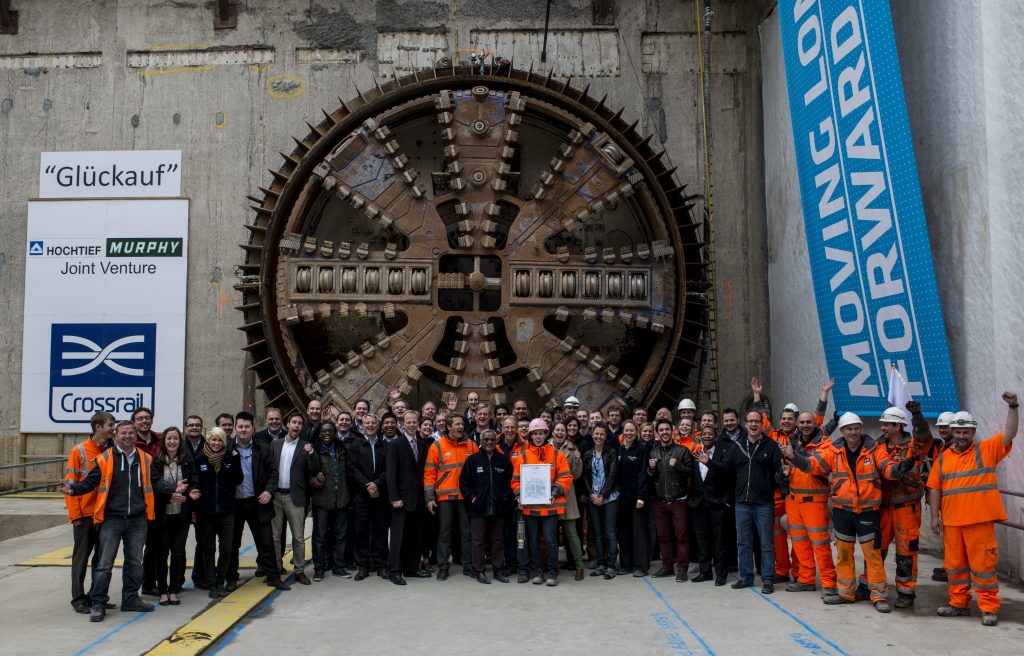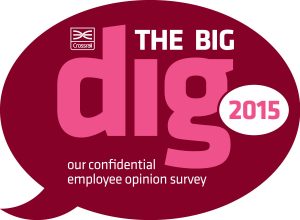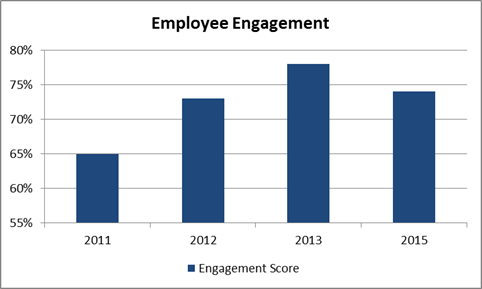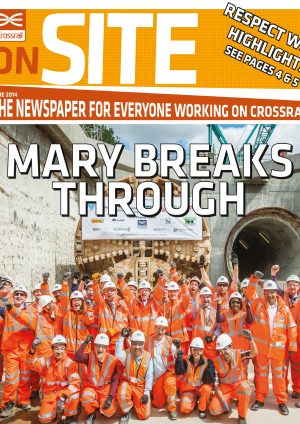
Employee Engagement
Document
type: Micro-report
Author:
Rob Jones, Richard Davies
Publication
Date: 27/09/2016
-
Abstract
This micro-report outlines Crossrail’s lessons learned on effective employee engagement across an integrated team of multiple sites and multiple partners. It highlights the benefits of including contractor staff as a key engagement audience.
The micro-report describes the tools employed, the outcomes achieved and concludes with the importance of project leaders engaging with staff and creating ‘I was there’ moments.
This micro-report would be of interest to communication specialists, marketing specialists, employee engagement specialists, organisational development practitioners.
-
Read the full document
Introduction
Since 2012, employee engagement at Crossrail has focused on building a culture aligned around the Vision, Mission and Values.
The core audience was the Crossrail ‘client’ delivery organisation which comprises 1,200 people from nine different employers, integrated into a single ‘Team Crossrail’.
The main goal was to inspire employees about the Vision, Mission and Values of Crossrail, to understand that Crossrail was building more than a railway. Specific challenges included:
- Engaging project based staff about the wider programme beyond their own project
- Engaging head office staff about the programme
- Engaging contractor and supply chain workforce who were critical to the success.
- Designing and delivering an engaging programme of events within the allocated budget
What Did Crossrail Do?
Developing the Plan
To determine how best to engage and communicate the workforce, Crossrail undertook an audience mapping exercise to determine the levels of influence and interest across key audience groups. As a large construction project, Crossrail had a wide audience range, from head office based staff, to site based construction staff, and needed to make sure that, Crossrail could communicate effectively with a wide range of audiences.
The audience mapping exercise was supported by a site communication assessment for Crossrail construction sites. This, combined with the audience mapping identified the best communication channels for reaching the Crossrail workforce.
Engagement by leaders
A major element of Crossrail’s leadership development was to support leaders in their primary employee engagement role, both in terms of skills development and understanding its importance to the success of the programme.
The senior executive team, the Executive & Investment Committee, committed to being highly visible to the organisation, for example by hosting briefing events for staff and contributing to a leadership blog.
In addition to holding regular one-to-ones and team meetings, line managers were actively encouraged to develop a positive team culture and teams were encouraged to participate enthusiastically in programme wide initiatives.
Regular communication channels
In support of the above, the internal communications team managed a wide range of both published and face to face communication channels:
Connect Online – an intranet site including daily news stories and a weekly leadership blog written by a member of Executive & Committee. Employees could rate and comment on stories.
Connect in Brief – a weekly e-mail newsletter for all members of Team Crossrail and any contractors who wanted to subscribe.
OnSite – a monthly tabloid style newspaper aimed at ‘hard to reach’ site based staff, particularly those without a work e-mail address.
Figure 1 – Onsite front page
Moving ahead video – a quarterly project highlights video hosted by a senior leader, with links distributed by intranet, e-mail and QR codes published in OnSite.
Toolbox talks – weekly face to face update on a health, safety or environmental theme
Leaders cascade – a team briefing powerpoint presentation providing a progress update on corporate goals, distributed every period for leaders to use in their team meetings.
All hands briefings – ‘big picture’ updates hosted by a member of the Executive & Investment Committee, including robust questions & answers, local awards presentations and a social event. The CEO, Programme Director and Finance Director each visited a different location each month, so that all main locations had an all hands briefing every 3-4 months.
Breakfast briefings – CEO visit to a different project site each month for an informal chat over breakfast with a mixed group of project staff and contractors.
Programme Leadership Team roadshow – an annual series of events to engage the Delivery team about the Programme Director’s key priorities
Leadership events – annual ‘top 250’ events to align leaders of Crossrail, contractors and partners around strategic priorities, supported by innovative cascade materials e.g. visual minutes summaries.
Figure 2 – Visual minutes summary 2013
Programme wide initiatives
In addition to the communications channels outlined above, the internal communications also supported several programme-wide initiatives. These are outlined below:
Crossrail Values – the values were promoted by a network of values champions and the values award scheme, resulting in over 400 monthly award winners each year.
Target Zero – as the primary Value, health & safety was a major focus for employee engagement, including the Gateway award scheme, ‘Have your Say’ surveys and themed ‘Stepping up for Health & Safety’ activity weeks.
Big Dig – with response rates in the upper 90 percentile, the annual employee engagement survey ‘Big Dig’ provided a valuable measure of what it was like to work at Crossrail. The Executive & Investment Committee members took personal responsibility for delivering improvements in response to feedback.
Sustainability – promoted through Green Line awards to reward projects for their environmental performance and annual programme wide sustainability awards.
Innovate18 – the innovation programme engaged staff via a network of innovation champions and a dedicated microsite to initiate and develop ideas
Quality – promoted through an annual activity week to raise awareness of quality issues
Diversity & Inclusion – promoted through a themed ‘Respect Week’ and a ‘One Crossrail’ campaign
Celebrating Success
Major milestones are celebrated by creating special events to give employees ‘I was there’ moments. With minimal budgets, these events are made possible by the enthusiasm and cooperation of project staff. Although logistically challenging to organise across Crossrail’s 40 worksites, the employee engagement benefits have been enormous. Examples to date include the following:
- 600 staff attended Woolwich station to witness a tunnel boring machine breakthrough
- The ‘halfway there’ campaign provided more than 40 opportunities for staff to visit a different site, including a ‘friends and family’ day event when 800+ people (including contractors) experienced a unique train ride through the Crossrail tunnels from Limmo to Canary Wharf
- To celebrate ‘End of Tunnelling’, 300 people took part in a tunnel walkthrough under the River Thames from Woolwich Arsenal to North Woolwich.
Figure 3 – Woolwich TBM Breakthrough Event
Outcomes
Overall employee engagement has been measured through the Big Dig survey at 12-18 month intervals as a composite figure of people who were satisfied with their job, satisfied with Crossrail as a place to work; loyal to Crossrail; motivated; and proud to work for Crossrail. From 2013, Crossrail also measured employee engagement by the diversity characteristics of: gender, age, disability and ethnicity.
Figure 4 – Big Dig Campaign
From a low of 65% in 2011, employee engagement peaked at 78% in 2013, thereafter remaining in the mid 70 percentile. As the Big Dig was completed at 12-18 month intervals, there was no Big Dig in 2014.
Figure 5 – Big Dig Survey Employee Engagement Outcomes
Lesson Learned
- Having leaders who are committed to employee engagement is critical to the success of the programme.
- Close public scrutiny of employee engagement costs should not excuse lack of ambition. Many of the most successful events had very low budgets, yet still provided rewarding and motivational experiences.
- Extending engagement activities to contractor employees is challenging and ultimately depends on the cooperation of contractor project directors. The Values programme and OnSite magazine proved effective in engaging this audience, but it would have been useful to have created more face-to-face opportunities for Crossrail leaders to talk directly to contractor staff to create higher levels of engagement.
- In 2013, Crossrail evaluated several social media platforms and conducted a pilot study. The conclusion was that given that Crossrail was at the halfway stage of the programme, the potential value of introducing a social media channel was outweighed by the risk of causing distraction, due to the investment required in changing behaviours. However, if introduced at the start of the programme, social media could provide a valuable engagement and collaboration tool.
Recommendations for Future Projects
- Invest in the ability of project leaders at all levels to engage employees effectively by providing a variety of engagement vehicles
- If possible celebrate success and create ‘I was there’ moments to remember major achievements and engage and motivate staff.
- Include contractor and supply chain workforce as a key engagement audience with tailored communication channels to target engagement with geographically dispersed workers who have limited access to technology.
- Consider use of a social media tool at the start of the programme as an engagement & collaboration tool.
-
Authors
Rob Jones
Rob Jones was the Head of Organisational Effectiveness at Crossrail until September 2016. Rob led the alignment and collaboration; talent development; and employee engagement work streams across the organisation. Rob joined Crossrail in 2012, and in that time the team has won awards for employee engagement, effectiveness and has achieved Investor in People accreditation. Prior to Crossrail, Rob lead the global Learning & Development team for a retailer working across the UK, Europe, South East Asia and the US having completed various talent roles in retail, fast moving consumer goods and publishing.
Richard Davies
Richard joined Crossrail in 2011 as an Employee Engagement Project Manager, initially to work on the launch of Crossrail’s Vision, Mission and Values, including authorship of Crossrail’s ‘ Little Pink Book’. As a member of the Organisational Effectiveness team, Richard played a lead role in developing Crossrail’s award winning employee engagement strategy, including design and delivery of the annual Crossrail leadership conference. Since leaving the project in 2016, he continues to support Crossrail as a communication coach and trainer. Previously, Richard worked as a senior change and employee communication specialist for major corporates including eBay, 02, BAA, Cadburys, London Underground and Unilever.
